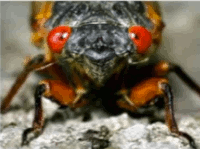
Common Core State Standard
SL.CCS.1/2/3/4 Grades 6-12: An essay of a current news event is provided for discussion to encourage participation, but also inspire the use of evidence to support logical claims using the main ideas of the article. Students must analyze background information provided about a current event within the news, draw out the main ideas and key details, and review different opinions on the issue. Then, students should present their own claims using facts and analysis for support. FOR THE WEEK OF MAY 13, 2013 Northeast braces for noisy invasion: Flying cicada bugs return after hiding for 17 yearsFind another article about nature or the environment and tell why it's of interest. What did you learn?
Now look for coverage from a different area of science or research. Tell why you would or wouldn't want to do the type of work described.
Select and discuss news about something coming to your area this spring, such as sports, entertainment or another event.
There's a buzz of talk about pesky insects that make a buzzing sound for real. They're known as cicadas (pronounced sih-KAY-duhz) -- 1 1/2-inch-long, slow-flying bugs with dark bodies and red eyes. Male cicadas are the noisy ones, sounding like a grass trimmer as they call to females. Scientists say the noise can reach 90 decibels — the same level as a lawnmower. Unlike ordinary cicadas seen occasionally in mid-summer, these ones appear just once every 17 years along the East Coast. This year's have been underground since 1996, shortly after they hatched from eggs, squirmed into the dirt and began sucking fluid from tree roots. Now they're ready to produce the next generation. They'll emerge in states from North Carolina to Connecticut by early June, once the soil temperature reaches 64 degrees. Rare sightings have been reported as far west as Nebraska and central Kansas. Some areas could have a couple million cicadas per street. (Yes, you read that right!) They don't bite or sting, but trees could lose small branches as they munch on leaves. For animals, they're a flying snack that's rich in protein. Birds, mice, raccoons, opossums and other animals eat cicadas. The spectacle, or nuisance, won't last long. Adults live only four to six weeks. But their 17-year life span after hatching makes them the longest-lived insects known.
Front Page Talking Points is written by
Alan Stamm for NIEonline.com, Copyright 2025
Front Page Talking Points Archive►U.S. actions at sea against suspected drug smugglers raise military law issues ►Say goodbye to new pennies, a coin that outlived its purpose after 232 years ►Show of force: U.S. naval and air buildup near Venezuela signals possible military action ►Google targets organized scammers in China to block online access ►U.S. government stays away again as global leaders hold yearly climate change strategy session ► Political fight over federal spending nearly interrupts food aid for needy Americans ►Quick removal of White House wing for large ballroom is latest flashpoint for Trump critics ►Instagram tightens limits for users under 18 amid persistent social media safety concerns ►Phone-free schools spread: 35 states now limit students' electronic devices ► Health Secretary Robert F. Kennedy Jr. puts federal childhood vaccine advice under review |

